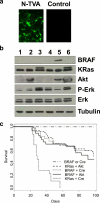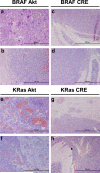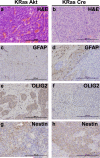Activated BRAF induces gliomas in mice when combined with Ink4a/Arf loss or Akt activation
- PMID: 19855433
- PMCID: PMC4109991
- DOI: 10.1038/onc.2009.333
Activated BRAF induces gliomas in mice when combined with Ink4a/Arf loss or Akt activation
Abstract
Mutations in receptor tyrosine kinase (RTK) growth factor receptors (epidermal growth factor receptor, platelet-derived growth factor receptor, MET and ERBB2), which result in downstream activation of the RAS/RAF/MEK/ERK mitogen-activated protein kinase (MAPK) pathway and PI(3)K/Akt pathway, are found in almost all high-grade gliomas and MAPK signaling is necessary for continued glioma maintenance. In addition, BRAF is mutated in the majority of low-grade gliomas and its expression and activity is significantly increased in the majority of high-grade gliomas. Although the importance of RTKs and RAS signaling in glioma development has been shown, the role of BRAF has yet to be characterized. We evaluated the effect of activated BRAF in glioma formation using the retroviral replication-competent avian leukosis virus long terminal repeat, splice acceptor (RCAS)/TVA system to transfer genes encoding activated forms of BRAF, KRas, Akt and Cre to nestin-expressing neural progenitor cells in Ink4a/Arf(lox/lox) mice in vivo. Although expression of activated BRAF alone is not sufficient for tumorigenesis, the combination of activated BRAF and Akt or BRAF with Ink4a/Arf loss is transforming. Interestingly, activated BRAF generates gliomas with characteristics similar to activated KRas in the context of Akt but not Ink4a/Arf loss. Our studies show a role for BRAF activation and signaling in glioma development and as potential target for glioma therapy.
Figures






References
-
- Balmanno K, Cook SJ. Tumour cell survival signalling by the ERK1/2 pathway. Cell Death Differ. 2009;16:368–77. - PubMed
-
- Barnier JV, Papin C, Eychene A, Lecoq O, Calothy G. The mouse B-raf gene encodes multiple protein isoforms with tissue-specific expression. J Biol Chem. 1995;270:23381–9. - PubMed
-
- Basto D, Trovisco V, Lopes JM, Martins A, Pardal F, Soares P, et al. Mutation analysis of B-RAF gene in human gliomas. Acta Neuropathol. 2005;109:207–10. - PubMed
Publication types
MeSH terms
Substances
Grants and funding
LinkOut - more resources
Full Text Sources
Other Literature Sources
Research Materials
Miscellaneous

